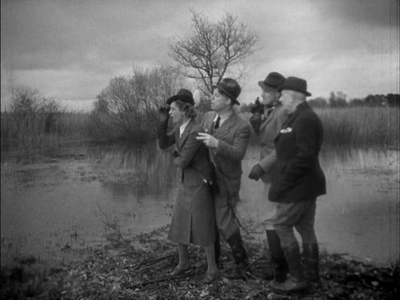Rules of the Game, 1939. On the eve of the Second World War, Renoir delivers a film depicting the life of the rich. Surprising, probably, when we know the difficulties France was going through in politics and economics. Surprising, not so much after all; when we learn a little bit more about the man behind one of the most admired film in cinema’s history, things clear up.

At first, it was difficult for me to figure out La Règle du jeu. I didn’t really see the point of the movie, where the director wanted us to go. So I started to investigate a little more on Jean Renoir and focus a little less on the movie itself. What I found surprised me at first: Renoir was very close to the french communist, his partner and editor being the daughter of an important union leader, and affiliated with diverse left wing associations. She fed him with marxist ideas, and he began to depict the situation of the workers, and moreover, the social structural in France at the time. After that, the movie became much more clearer. Renoir was simply heavily criticizing the high society, making a movie about their luxurious life, easy pleasures and light love while Europe was undoubtedly falling in war again. The characters show no kind of evidence of interest in the context their are living in, and it was at the time the movie was released the best way to, on one side show the desperate pointlessness of this social class, and at the same time, dramatically showing the imminence of the war, by astonishing the audience with its absence!

A very vivid example of that non-interest and blindness to the social and political context is the reiterated motif of the musical box, until its climax during the party, when Robert presents to his hosts his most recent acquisition, this huge automated music machine. This object can be seen as a symbol of the automation of the high society’s life. They live as if it was still a monarchy regime, enjoying privileges as if the world continued to go the same. This was probably intolerable for Renoir, who decided to ridiculize it.

Let’s now talk about how the movie and particular scenes seem to have survived the decades. For me, the most impressive scene both visually and symbolically was the hunting scene. I argue we can consider it as one of the climax of the film, together with the shooting of André Jurieux, its equal and direct reply. The way the advent of the scene is prepared, its close-ups on both the hunters and the hunted, its fine montage, building up the tension until the first shot, announcing the start of the massacre; all of these elements have a strong impression on the 21st century viewer I am, and I noticed other perceptible signs of reactions in the audience. Finally, this sequence has a very strong implication on Renoir’s condemnation of war, prophesying the horrors of the conflict to come.  On the the other side, I found the scene taking place in Robert’s first home in the city less interesting. The purpose of the scene was setting up the different relations in place between the characters and present the future conflicts that will take place in the countryside. The long discourses of the characters seemed slightly passed, although provided a nice end-of-the-30s charm, which I finally appreciated.
On the the other side, I found the scene taking place in Robert’s first home in the city less interesting. The purpose of the scene was setting up the different relations in place between the characters and present the future conflicts that will take place in the countryside. The long discourses of the characters seemed slightly passed, although provided a nice end-of-the-30s charm, which I finally appreciated. 

Nice Blog Review!